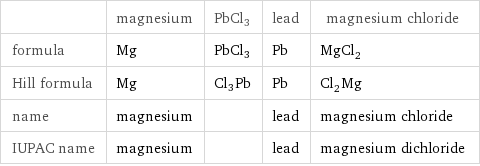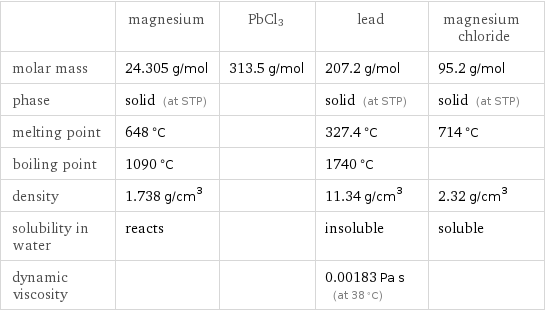Input interpretation

Mg magnesium + PbCl3 ⟶ Pb lead + MgCl_2 magnesium chloride
Balanced equation

Balance the chemical equation algebraically: Mg + PbCl3 ⟶ Pb + MgCl_2 Add stoichiometric coefficients, c_i, to the reactants and products: c_1 Mg + c_2 PbCl3 ⟶ c_3 Pb + c_4 MgCl_2 Set the number of atoms in the reactants equal to the number of atoms in the products for Mg, Pb and Cl: Mg: | c_1 = c_4 Pb: | c_2 = c_3 Cl: | 3 c_2 = 2 c_4 Since the coefficients are relative quantities and underdetermined, choose a coefficient to set arbitrarily. To keep the coefficients small, the arbitrary value is ordinarily one. For instance, set c_2 = 1 and solve the system of equations for the remaining coefficients: c_1 = 3/2 c_2 = 1 c_3 = 1 c_4 = 3/2 Multiply by the least common denominator, 2, to eliminate fractional coefficients: c_1 = 3 c_2 = 2 c_3 = 2 c_4 = 3 Substitute the coefficients into the chemical reaction to obtain the balanced equation: Answer: | | 3 Mg + 2 PbCl3 ⟶ 2 Pb + 3 MgCl_2
Structures

+ PbCl3 ⟶ +
Names

magnesium + PbCl3 ⟶ lead + magnesium chloride
Equilibrium constant
![Construct the equilibrium constant, K, expression for: Mg + PbCl3 ⟶ Pb + MgCl_2 Plan: • Balance the chemical equation. • Determine the stoichiometric numbers. • Assemble the activity expression for each chemical species. • Use the activity expressions to build the equilibrium constant expression. Write the balanced chemical equation: 3 Mg + 2 PbCl3 ⟶ 2 Pb + 3 MgCl_2 Assign stoichiometric numbers, ν_i, using the stoichiometric coefficients, c_i, from the balanced chemical equation in the following manner: ν_i = -c_i for reactants and ν_i = c_i for products: chemical species | c_i | ν_i Mg | 3 | -3 PbCl3 | 2 | -2 Pb | 2 | 2 MgCl_2 | 3 | 3 Assemble the activity expressions accounting for the state of matter and ν_i: chemical species | c_i | ν_i | activity expression Mg | 3 | -3 | ([Mg])^(-3) PbCl3 | 2 | -2 | ([PbCl3])^(-2) Pb | 2 | 2 | ([Pb])^2 MgCl_2 | 3 | 3 | ([MgCl2])^3 The equilibrium constant symbol in the concentration basis is: K_c Mulitply the activity expressions to arrive at the K_c expression: Answer: | | K_c = ([Mg])^(-3) ([PbCl3])^(-2) ([Pb])^2 ([MgCl2])^3 = (([Pb])^2 ([MgCl2])^3)/(([Mg])^3 ([PbCl3])^2)](../image_source/70a711f967a5d25159624ae759ced45d.png)
Construct the equilibrium constant, K, expression for: Mg + PbCl3 ⟶ Pb + MgCl_2 Plan: • Balance the chemical equation. • Determine the stoichiometric numbers. • Assemble the activity expression for each chemical species. • Use the activity expressions to build the equilibrium constant expression. Write the balanced chemical equation: 3 Mg + 2 PbCl3 ⟶ 2 Pb + 3 MgCl_2 Assign stoichiometric numbers, ν_i, using the stoichiometric coefficients, c_i, from the balanced chemical equation in the following manner: ν_i = -c_i for reactants and ν_i = c_i for products: chemical species | c_i | ν_i Mg | 3 | -3 PbCl3 | 2 | -2 Pb | 2 | 2 MgCl_2 | 3 | 3 Assemble the activity expressions accounting for the state of matter and ν_i: chemical species | c_i | ν_i | activity expression Mg | 3 | -3 | ([Mg])^(-3) PbCl3 | 2 | -2 | ([PbCl3])^(-2) Pb | 2 | 2 | ([Pb])^2 MgCl_2 | 3 | 3 | ([MgCl2])^3 The equilibrium constant symbol in the concentration basis is: K_c Mulitply the activity expressions to arrive at the K_c expression: Answer: | | K_c = ([Mg])^(-3) ([PbCl3])^(-2) ([Pb])^2 ([MgCl2])^3 = (([Pb])^2 ([MgCl2])^3)/(([Mg])^3 ([PbCl3])^2)
Rate of reaction
![Construct the rate of reaction expression for: Mg + PbCl3 ⟶ Pb + MgCl_2 Plan: • Balance the chemical equation. • Determine the stoichiometric numbers. • Assemble the rate term for each chemical species. • Write the rate of reaction expression. Write the balanced chemical equation: 3 Mg + 2 PbCl3 ⟶ 2 Pb + 3 MgCl_2 Assign stoichiometric numbers, ν_i, using the stoichiometric coefficients, c_i, from the balanced chemical equation in the following manner: ν_i = -c_i for reactants and ν_i = c_i for products: chemical species | c_i | ν_i Mg | 3 | -3 PbCl3 | 2 | -2 Pb | 2 | 2 MgCl_2 | 3 | 3 The rate term for each chemical species, B_i, is 1/ν_i(Δ[B_i])/(Δt) where [B_i] is the amount concentration and t is time: chemical species | c_i | ν_i | rate term Mg | 3 | -3 | -1/3 (Δ[Mg])/(Δt) PbCl3 | 2 | -2 | -1/2 (Δ[PbCl3])/(Δt) Pb | 2 | 2 | 1/2 (Δ[Pb])/(Δt) MgCl_2 | 3 | 3 | 1/3 (Δ[MgCl2])/(Δt) (for infinitesimal rate of change, replace Δ with d) Set the rate terms equal to each other to arrive at the rate expression: Answer: | | rate = -1/3 (Δ[Mg])/(Δt) = -1/2 (Δ[PbCl3])/(Δt) = 1/2 (Δ[Pb])/(Δt) = 1/3 (Δ[MgCl2])/(Δt) (assuming constant volume and no accumulation of intermediates or side products)](../image_source/cfb70f552a42d6f1b51e65e3196b5bd5.png)
Construct the rate of reaction expression for: Mg + PbCl3 ⟶ Pb + MgCl_2 Plan: • Balance the chemical equation. • Determine the stoichiometric numbers. • Assemble the rate term for each chemical species. • Write the rate of reaction expression. Write the balanced chemical equation: 3 Mg + 2 PbCl3 ⟶ 2 Pb + 3 MgCl_2 Assign stoichiometric numbers, ν_i, using the stoichiometric coefficients, c_i, from the balanced chemical equation in the following manner: ν_i = -c_i for reactants and ν_i = c_i for products: chemical species | c_i | ν_i Mg | 3 | -3 PbCl3 | 2 | -2 Pb | 2 | 2 MgCl_2 | 3 | 3 The rate term for each chemical species, B_i, is 1/ν_i(Δ[B_i])/(Δt) where [B_i] is the amount concentration and t is time: chemical species | c_i | ν_i | rate term Mg | 3 | -3 | -1/3 (Δ[Mg])/(Δt) PbCl3 | 2 | -2 | -1/2 (Δ[PbCl3])/(Δt) Pb | 2 | 2 | 1/2 (Δ[Pb])/(Δt) MgCl_2 | 3 | 3 | 1/3 (Δ[MgCl2])/(Δt) (for infinitesimal rate of change, replace Δ with d) Set the rate terms equal to each other to arrive at the rate expression: Answer: | | rate = -1/3 (Δ[Mg])/(Δt) = -1/2 (Δ[PbCl3])/(Δt) = 1/2 (Δ[Pb])/(Δt) = 1/3 (Δ[MgCl2])/(Δt) (assuming constant volume and no accumulation of intermediates or side products)
Chemical names and formulas

| magnesium | PbCl3 | lead | magnesium chloride formula | Mg | PbCl3 | Pb | MgCl_2 Hill formula | Mg | Cl3Pb | Pb | Cl_2Mg name | magnesium | | lead | magnesium chloride IUPAC name | magnesium | | lead | magnesium dichloride
Substance properties

| magnesium | PbCl3 | lead | magnesium chloride molar mass | 24.305 g/mol | 313.5 g/mol | 207.2 g/mol | 95.2 g/mol phase | solid (at STP) | | solid (at STP) | solid (at STP) melting point | 648 °C | | 327.4 °C | 714 °C boiling point | 1090 °C | | 1740 °C | density | 1.738 g/cm^3 | | 11.34 g/cm^3 | 2.32 g/cm^3 solubility in water | reacts | | insoluble | soluble dynamic viscosity | | | 0.00183 Pa s (at 38 °C) |
Units
